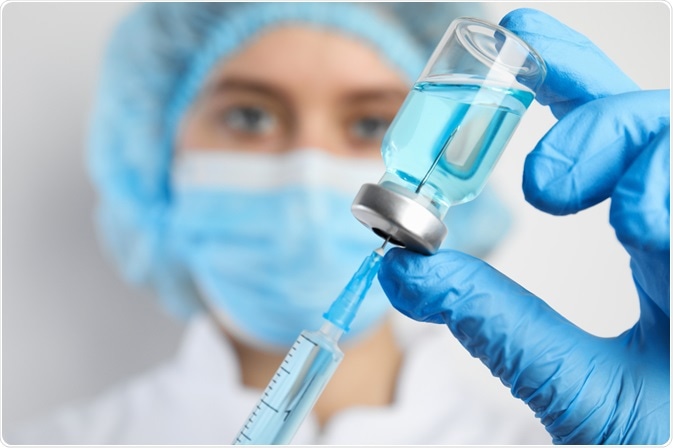Traditional vaccination approaches practically eradicated several extremely infectious diseases around the world. Despite their success, these conventional approaches are insufficient in their ability to target many other important pathogens. Several alternative vaccination approaches, such as a subunit vaccine, have been developed to overcome these limitations.

Image Credit: New Africa/Shutterstock.com
Introduction
The ideal vaccine against any disease will be highly immunogenic, prevent any autoimmune or hypersensitivity reactions from occurring, be easy to administer, and have simple storage requirements. In addition to these properties, vaccines should also be safe for human and/or animal administration and should not itself result in the disease state.
Over the past several decades, different types of vaccines have been developed to safely induce an immune response in individuals to protect against infection by numerous other pathogens.
Traditionally, vaccines have consisted of entire pathogens that can elicit a robust immune response without causing the immunized individual to experience the disease. The three different types of whole-pathogen vaccines include inactivated live-attenuated and chimeric vaccines.
Whereas pathogens are killed with chemicals, heat, or radiation before incorporating inactivated vaccines, a live-attenuated vaccine instead contains a weakened version of the target pathogen. Many whole-pathogen vaccines are widely distributed throughout the world; however, many different pathogens cannot be effectively targeted through this vaccine approach.
Defining a subunit vaccine
Compared to a whole-pathogen vaccine approach, a subunit vaccine will only include specific components originating from disease-causing bacteria, parasites, or viruses. These components, otherwise known as antigens, are highly purified proteins or synthetic peptides that are significantly safer than whole-pathogen vaccine approaches.
Despite these advantages, the antigens that comprise a subunit vaccine are very small and lack pathogen-associated molecular patterns (PAMPs) required for antigen recognition by the host immune system, thereby reducing the immunogenicity potential of this vaccine approach.
An additional weakness of subunit vaccines is due to the potential denaturation of antigens that can occur, which can subsequently cause the proteins to bind to different antibodies rather than the specific antigens that target the pathogen.
What are adjuvants?
Since the antigens alone in a subunit vaccine are insufficient to produce high immunogenicity, non-immunogenic materials known as adjuvants are typically incorporated into the vaccine formulation to improve the immune response and enhance the vaccine's efficacy.
Since the 1930s, trace amounts of aluminum-containing adjuvants, otherwise referred to as alum, have been approved for their incorporation into subunit vaccines. As one of the most common metals found in nature, food, and water supplies, aluminum adjuvants are not readily absorbed by the body and are therefore regarded as safe when used in vaccines.
As technology has advanced over the past several decades, researchers have identified many new and promising adjuvant candidates. In 2009, for example, the United States Food and Drug Administration (FDA) approved the first vaccine against the human papillomavirus (HPV), which contained a novel adjuvant known as AS04, which is a combination of both the TLR4 agonist 2-O-desacyl-4’-monophosphoryl lipid A (MPL) and aluminum salt.
Since then, several natural adjuvants have also been explored for their ability to enhance the immunogenicity of vaccines without causing toxicity or reactogenicity. In recent years, an increasing amount of attention has been dedicated to advancing the use of natural and synthetic polymers like chitosan, alginate, hyaluronic acid (HA), and poly(lactic-co-glycolic acid) (PLGA) as adjuvants in subunit vaccines.
Approved subunit vaccines
The first subunit vaccine to be approved for use in humans in the United States is the hepatitis B vaccine, which comprises hepatitis B virus surface antigens (HBsAg) that originate from the hepatitis B virus. Although the original hepatitis B subunit vaccine obtained HBsAg from the plasma of infected individuals, modern recombinant technology has allowed for these vaccines to be developed without requiring the use of human plasma samples.
This technological advancement has significantly improved the hepatitis B vaccine's safety by eliminating any potential contamination that can occur when researchers handle human plasma. In addition, the vaccine targeting acellular pertussis (aP) is another type of subunit vaccine that is made up of the inactivated pertussis toxin and one or more other components of this bacteria microorganism.
Future directions
Subunit vaccines are associated with excellent safety profiles; however, researchers interested in developing novel subunit vaccines often face difficulties identifying suitable antigens or proteins that offer good immunogenic potential and protective efficiency to the host.
In addition to identifying effective antigens that could be incorporated into future subunit vaccines, it is also critical for researchers to develop potent immunostimulatory adjuvants that can be used to enhance the potency of these vaccine types.
Subunit vaccines are considered promising candidates for developing immunizations against malaria, tetanus, human cytomegalovirus, Salmonella enterica serovar Enteritidis infections, and even the novel severe acute respiratory syndrome coronavirus 2 (SARS-CoV-2).
References
Further Reading